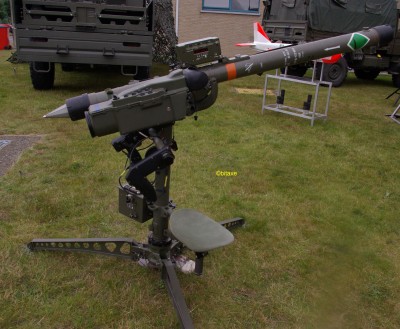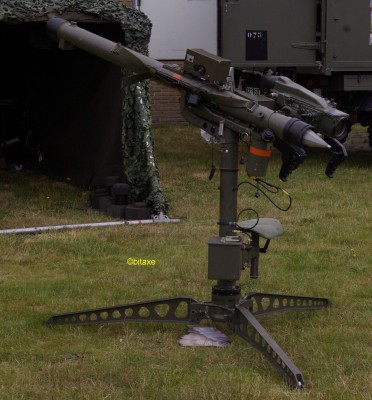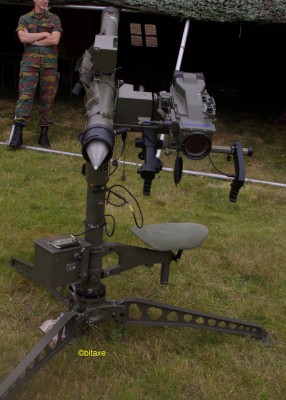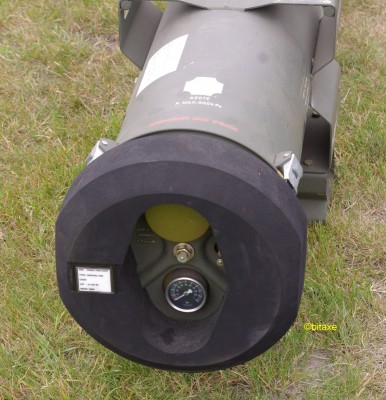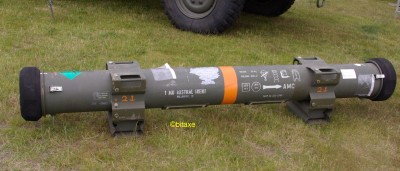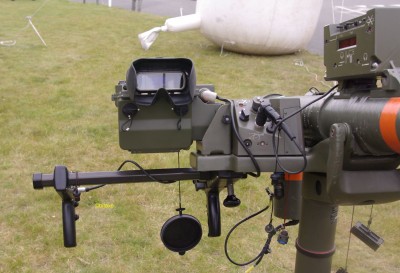| Název: Name: | Mistral SATCP | Mistral SATCP |
| Originální název: Original Name: | Mistral SATCP | |
| Kategorie: Category: | přenosný protiletadlový komplet velmi krátkeho dosahu | very short range man-portable air-defense system |
| Výrobce: Producer: | DD.MM.1988-DD.08.1996 Matra Defense, ? DD.MM.199R-DD.MM.RRRR Ital-Missile Group, ? DD.08.1996-DD.MM.2002 Matra BAe Dynamics, ? DD.MM.2002-DD.MM.RRRR MBDA France, ? | |
| Období výroby: Production Period: | DD.MM.1988-DD.MM.RRRR | |
| Vyrobeno kusů: Number of Produced: | ? | |
| Prototyp vyroben: Prototype Built: | DD.MM.1983 | |
| Složení: Composition: | ||
| Střela / Munice: Missile / Ammunition: | Mistral 1 Mistral 2 Mistral 3 | |
| Odpalovací / Palebné prostředky: Launch / Firing Means: | trojnožka se spouštěcím ústrojenstvím | |
| Prostředky velení, řízení a průzkumu: Command, Control and Surveillance Means: | PMCC (Platoon Mistral Command Centre) / MCP (Mistral coordination post) / PCP (Platoon Command Post) | |
| Prostředky technického zabezpečení: Technical Support Means: | ? | |
| Výcvikové prostředky: Training Means: | ? | |
| Mobilita: Mobility: | přenosný | portable |
| Uživatelské státy: User States: | ... | ... |
| Poznámka: Note: | MISTRAL - Missile Transportable Anti-aérien Léger - Ľahká protilietadlová prenosná strela SATCP - Sol-Air à Très Courte Portée - zem-vzduch veľmi krátkeho dosahu | MISTRAL - Missile Transportable Anti-aérien Léger - Light Anti-Aircraft Transportable Missile SATCP - Sol-Air à Très Courte Portée - Very Short Range Ground-to-Air |
| Zdroje: Sources: | https://en.wikipedia.org/wiki/Mistral_(missile) Christopher F. Foss, Tony Cullen: Jane's Land-Based Air Defence 1992-93; Jane's Information Group, 1992 www.mbda-systems.com | |
Mistral SATCP (přenosný protiletadlový raketový komplet)
Mistral SATCP
Mistral SATCP
The Mistral (Missile Transportable Anti-Aircraft Léger) is a man-portable anti-aircraft missile system developed by Matra Defense SA. An infrared homing system is used to guide the missile to the target. Several sources date the early development of the Mistral ICBM to 1974.
In 1977, a technology group was set up by the leadership of the French Armed Forces to assess various designs for very short-range anti-aircraft missile systems that would meet the requirements of all three branches of the armed forces - this process was translated into the SATCP (Sol-Air à Très Courte Portée) project in 1979. The project involved 5 companies, which submitted their proposals in March 1980. Following an evaluation of these proposals, the proposals of Matra Aerospatiale and Thomson-Brandt were taken forward for further development. In September of the same year, on the basis of additional technical and feasibility studies, it was decided to implement Matra's project, and on 1 December 1980 a contract was awarded to Matra to develop a basic version of the complex on a portable tripod. In addition to Matra, SAT (Societe Anonyme de Telecommunications) - responsible for the self-launching warhead, SEP (Societe Europeenne de Propulsion) - the rocket motor, SNPE (Societe Nationale des Poudres et Explosifs) - the solid rocket propellant, SAFT (Surface Power Source - thermal batteries) and Manurhin - the warhead, the fuse mechanism and the rocket launcher - also participated in the development through subcontracts.
In 1983, practical tests of the prototypes began. The whole development and testing process lasted until March 1988, when it was decided to introduce the MISTRAL complex into the armament.The initial order from the French Armed Forces came in March 1988 and included a requirement for 2300 missiles for all three components. The first sets were delivered to the ground forces and the air force during 1988, with a significant increase over the original order. The refined requirements from the ground forces were for 500 launchers in the ground version of the SATCP and the air version of the AATCP (Air-Air Tres Courte Portee - for the use of the missiles on Gazelle helicopters) and 5,000 missiles. The Air Force requested 400 ground launchers and 4,000 missiles.
Gradually,versions were developed (but not all of them went into series production):
- Mistral SATCP - a land-based portable anti-aircraft missile of very short range.
- Mistral AATCP - a very short-range air-to-air anti-aircraft missile suite. When installed on helicopters, the kit allows to control up to 4 launchers (each carrying a pair of missiles, 8 pieces in total) installed on weapon slings (Gazelle, AH-64, Tigre, etc.).
- ALAMO (Affut Leger Anti-aerien MObile) - Adaptation of a land-based launcher to light vehicles, e.g. Peugeot-Mercedes, Jeep, FL-500 Lohr ATV, VLRA ACMAT 4x4, Matra Poncin ATV, exported to Cyprus.
- ALBI (ALBI (Affut Leger Bimunition)) - turret-mounted version with two missiles designed for light armoured wheeled and tracked vehicles (Panhard VBL, SMS VAB). The system can be supplemented with night vision and IFF.
- The ATLAS (Affut Terrestre Leger Anti-Saturation) is a portable version with two missiles. The tripod design allows it from the ground, but also easy attachment to vehicle platforms. In addition to the basic version, a remote-controlled version ATLAS RC is also available.
- The SANTAL - a modification for 6 missiles designed to be mounted on armored vehicles and usable in all weather.
- ASPICASPIC - remote controlled launcher with 4 rocket launchers for light vehicles.
- The MPCV - a light vehicle launcher with 4 MISTRAL missiles and a heavy machine gun, or small caliber cannon and electro-optical fire control system.
- The PAMELA - a manually operated single rocket launcher designed for mounting on VLRA vehicles, TRM 2000.
- SADRAL (Systeme d'Autodefense Rapproche Anti-aerien Leger) - a naval version designed for all-weather use. The 1500 kg basic module contains 6 missiles and all the necessary components to ensure operation within the vessel's combat system. Exported to Finland and the United Arab Emirates in addition to the French Navy.
- The Simbad - a naval version with two missiles designed for small vessels. In addition to the manually operated version, a remote-controlled version Simbad RC is also available.
- TETRIL - naval version with 4 Mistral missiles and electro-optical or radar fire control system.
- SIGMA - naval version, combination of 25 or 30mm gun with three Mistral missiles and electro-optical or radar fire control system.
- SAKO M85 MistralSAKO M85 Mistral - Finnish remote-controlled SAKO 23 M85 turret, where the original ZU-23-2 gun was replaced by 6 Mistral missiles.
The Mistral SAM is capable of interfacing with Mygale's automated air defense command systems. For command level units armed with portable SATCP and ATLAS kits, the PMCC (Platoon Mistral Command Centre) vehicle was introduced in 1991, providing air reconnaissance, target recognition and fire control at platoon level and communications (voice and data) with higher command levels. Later, other means of providing command and communications were also redesigned to reflect technological advances.
In 1997, a 2nd generation missile referred to as Mistral 2 (Mistral M2, Mistral Mk. 2) was introduced for the suite, and in November 2019, a 3rd generation missile, Mistral 3 (Mistral M3, Mistral Mk. 3) was introduced.
Source: https://en.wikipedia.org/wiki/Mistral_(missile)
In 1977, a technology group was set up by the leadership of the French Armed Forces to assess various designs for very short-range anti-aircraft missile systems that would meet the requirements of all three branches of the armed forces - this process was translated into the SATCP (Sol-Air à Très Courte Portée) project in 1979. The project involved 5 companies, which submitted their proposals in March 1980. Following an evaluation of these proposals, the proposals of Matra Aerospatiale and Thomson-Brandt were taken forward for further development. In September of the same year, on the basis of additional technical and feasibility studies, it was decided to implement Matra's project, and on 1 December 1980 a contract was awarded to Matra to develop a basic version of the complex on a portable tripod. In addition to Matra, SAT (Societe Anonyme de Telecommunications) - responsible for the self-launching warhead, SEP (Societe Europeenne de Propulsion) - the rocket motor, SNPE (Societe Nationale des Poudres et Explosifs) - the solid rocket propellant, SAFT (Surface Power Source - thermal batteries) and Manurhin - the warhead, the fuse mechanism and the rocket launcher - also participated in the development through subcontracts.
In 1983, practical tests of the prototypes began. The whole development and testing process lasted until March 1988, when it was decided to introduce the MISTRAL complex into the armament.The initial order from the French Armed Forces came in March 1988 and included a requirement for 2300 missiles for all three components. The first sets were delivered to the ground forces and the air force during 1988, with a significant increase over the original order. The refined requirements from the ground forces were for 500 launchers in the ground version of the SATCP and the air version of the AATCP (Air-Air Tres Courte Portee - for the use of the missiles on Gazelle helicopters) and 5,000 missiles. The Air Force requested 400 ground launchers and 4,000 missiles.
Gradually,versions were developed (but not all of them went into series production):
- Mistral SATCP - a land-based portable anti-aircraft missile of very short range.
- Mistral AATCP - a very short-range air-to-air anti-aircraft missile suite. When installed on helicopters, the kit allows to control up to 4 launchers (each carrying a pair of missiles, 8 pieces in total) installed on weapon slings (Gazelle, AH-64, Tigre, etc.).
- ALAMO (Affut Leger Anti-aerien MObile) - Adaptation of a land-based launcher to light vehicles, e.g. Peugeot-Mercedes, Jeep, FL-500 Lohr ATV, VLRA ACMAT 4x4, Matra Poncin ATV, exported to Cyprus.
- ALBI (ALBI (Affut Leger Bimunition)) - turret-mounted version with two missiles designed for light armoured wheeled and tracked vehicles (Panhard VBL, SMS VAB). The system can be supplemented with night vision and IFF.
- The ATLAS (Affut Terrestre Leger Anti-Saturation) is a portable version with two missiles. The tripod design allows it from the ground, but also easy attachment to vehicle platforms. In addition to the basic version, a remote-controlled version ATLAS RC is also available.
- The SANTAL - a modification for 6 missiles designed to be mounted on armored vehicles and usable in all weather.
- ASPICASPIC - remote controlled launcher with 4 rocket launchers for light vehicles.
- The MPCV - a light vehicle launcher with 4 MISTRAL missiles and a heavy machine gun, or small caliber cannon and electro-optical fire control system.
- The PAMELA - a manually operated single rocket launcher designed for mounting on VLRA vehicles, TRM 2000.
- SADRAL (Systeme d'Autodefense Rapproche Anti-aerien Leger) - a naval version designed for all-weather use. The 1500 kg basic module contains 6 missiles and all the necessary components to ensure operation within the vessel's combat system. Exported to Finland and the United Arab Emirates in addition to the French Navy.
- The Simbad - a naval version with two missiles designed for small vessels. In addition to the manually operated version, a remote-controlled version Simbad RC is also available.
- TETRIL - naval version with 4 Mistral missiles and electro-optical or radar fire control system.
- SIGMA - naval version, combination of 25 or 30mm gun with three Mistral missiles and electro-optical or radar fire control system.
- SAKO M85 MistralSAKO M85 Mistral - Finnish remote-controlled SAKO 23 M85 turret, where the original ZU-23-2 gun was replaced by 6 Mistral missiles.
The Mistral SAM is capable of interfacing with Mygale's automated air defense command systems. For command level units armed with portable SATCP and ATLAS kits, the PMCC (Platoon Mistral Command Centre) vehicle was introduced in 1991, providing air reconnaissance, target recognition and fire control at platoon level and communications (voice and data) with higher command levels. Later, other means of providing command and communications were also redesigned to reflect technological advances.
In 1997, a 2nd generation missile referred to as Mistral 2 (Mistral M2, Mistral Mk. 2) was introduced for the suite, and in November 2019, a 3rd generation missile, Mistral 3 (Mistral M3, Mistral Mk. 3) was introduced.
Source: https://en.wikipedia.org/wiki/Mistral_(missile)
Christopher F. Foss, Tony Cullen: Jane's Land-Based Air Defence 1992-93; Jane's Information Group, 1992
Reklama
This post has not been translated to English yet. Please use the TRANSLATE button above to see machine translation of this post.
zdroj vlastní foto
| Period | - |
| Type | - |
| Camouflage | - |
| Country | - |
| Production No. | - |
| Poznávací značka / evidenční číslo | - |
| Tactical marking | - |
| Name | - |
| Unit | - |
| Date (DD.MM.RRRR) | - |
| Author | - |
| Print size / 300 DPI | - |
| Published with authors permit | - |
| Author Website | - |
| Period | - |
| Type | - |
| Camouflage | - |
| Country | - |
| Production No. | - |
| Poznávací značka / evidenční číslo | - |
| Tactical marking | - |
| Name | - |
| Unit | - |
| Date (DD.MM.RRRR) | - |
| Author | - |
| Print size / 300 DPI | - |
| Published with authors permit | - |
| Author Website | - |
| Period | - |
| Type | - |
| Camouflage | - |
| Country | - |
| Production No. | - |
| Poznávací značka / evidenční číslo | - |
| Tactical marking | - |
| Name | - |
| Unit | - |
| Date (DD.MM.RRRR) | - |
| Author | - |
| Print size / 300 DPI | - |
| Published with authors permit | - |
| Author Website | - |
| Period | - |
| Type | - |
| Camouflage | - |
| Country | - |
| Production No. | - |
| Poznávací značka / evidenční číslo | - |
| Tactical marking | - |
| Name | - |
| Unit | - |
| Date (DD.MM.RRRR) | - |
| Author | - |
| Print size / 300 DPI | - |
| Published with authors permit | - |
| Author Website | - |
| Period | - |
| Type | - |
| Camouflage | - |
| Country | - |
| Production No. | - |
| Poznávací značka / evidenční číslo | - |
| Tactical marking | - |
| Name | - |
| Unit | - |
| Date (DD.MM.RRRR) | - |
| Author | - |
| Print size / 300 DPI | - |
| Published with authors permit | - |
| Author Website | - |
This post has not been translated to English yet. Please use the TRANSLATE button above to see machine translation of this post.
zdroj : vlastní foto
| Period | - |
| Type | - |
| Camouflage | - |
| Country | - |
| Production No. | - |
| Poznávací značka / evidenční číslo | - |
| Tactical marking | - |
| Name | - |
| Unit | - |
| Date (DD.MM.RRRR) | - |
| Author | - |
| Print size / 300 DPI | - |
| Published with authors permit | - |
| Author Website | - |
Immediately after the start of the serial production of the kit, orders from abroad also appeared. Among the first was an order for the Belgian Armed Forces in November 1988, worth 3.5 billion Belgian francs. In addition to the SATCP launchers, the Belgian Ground Forces required 750 missiles with an option for a further 300. Italy ordered 450 SATCP sets and 4500 missiles - with 75% of the contract to be produced under licence by the Ital-Missile Group (a grouping of SNIA-BPD, Melara and Selenia). Of the European countries, Spain and Norway (for use from ships) have also ordered a portable version during this period. A maritime version SIMBAD has been ordered by Finland.
Asian countries have also expressed interest, with Qatar, Saudi Arabia (100 launchers and 700 missiles), Singapore, Malaysia and Cyprus ordering the SATCP version. The latter has ordered the ALAMO version in addition to the SATCP version. The naval version SIMBAD was exported to the United Arab Emirates. South American Chile also became a user of the portable version of the complex during this period. From Africa, the Mistral was ordered by Gabon (ASPIC version) and Kenya (ALBI version).
Asian countries have also expressed interest, with Qatar, Saudi Arabia (100 launchers and 700 missiles), Singapore, Malaysia and Cyprus ordering the SATCP version. The latter has ordered the ALAMO version in addition to the SATCP version. The naval version SIMBAD was exported to the United Arab Emirates. South American Chile also became a user of the portable version of the complex during this period. From Africa, the Mistral was ordered by Gabon (ASPIC version) and Kenya (ALBI version).
Source:Christopher F. Foss, Tony Cullen: Jane's Land-Based Air Defence 1992-93; Jane's Information Group, 1992
Reklama
Join us
We believe that there are people with different interests and experiences who could contribute their knowledge and ideas. If you love military history and have experience in historical research, writing articles, editing text, moderating, creating images, graphics or videos, or simply have a desire to contribute to our unique system, you can join us and help us create content that will be interesting and beneficial to other readers.
Find out more